Morocco
In early May, Bridget and I visited Morocco for the third time using the services of the excellent Gayuin Birding Tours http://gayuin.com Most of the photographs in the blogpost that follows are mine except for a few of the better ones taken on 8th May by Hamid Birdwatching https://www.facebook.com/profile.php?id=100010514010519
Tuesday 3rd May
Our half full EasyJet flight from Gatwick North Terminal departed bang on time at 06:25, arriving just over 3 hours later at a cloudy Marrakech. Immigration was the usual protracted affair (how long does it take to scrutinise a passport?) but surprisingly there was no checking of our Covid paperwork and seemingly no need for the ‘mandatory’ PCR tests we’d had done less than 48 hours before. Having reclaimed our baggage and changed some money into local currency (£1 = 11.7 Dirham), we headed out of the arrival hall where the familiar face of Hamid was there to meet us and our first Moroccan birds (Kestrel, Pallid Swift and Spotless Starling) were noted.
Hamid explained that the plan was to drive for 1.5 hours to Oukaimeden, the winter ski resort in the High Atlas we’d visited in January 2018. A handful of White Storks and a Maghreb Magpie helped pass the journey to Oukaimeden which looked very different to our last visit with few people around and what little remaining snow there was restricted to the highest peaks. It was also a lot colder than expected with the van thermometer registering a chilly 6C and a cold wind blowing. Undeterred, we put on the few warm clothes we had and set off towards the shepherds’ huts. It did not take long to find the first of our target birds for the trip – Seebohm’s Wheatear, a smart male (the first of five we were to see) which, judging by the food it was carrying, had a nest nearby. Also seen around the shepherds’ huts were a mobile flock of 50 Rock Sparrows, 3 Atlas Horned Larks, 3+ Crag Martins, a Black Redstart, a distant Little Owl perched on top of a rock and an African Chaffinch. Scrutiny of the flocks of Choughs flying around revealed both species to be present with estimates of 30 Alpine and 10 Red-billed.
A male Black Redstart was seen over lunch (the inevitable chicken & vegetable tagine) and a flock of 40 seemingly wild Rock Doves feeding on the roadside as we were leaving.
Having checked in to our hotel for the night (Auberge le Maquis) we spent a couple of hours before dinner birding along the river at Ourika while Hamid returned to Marrakech to have a strange noise coming from the wheel of the van checked out. Birds seen here were Cattle Egret, Grey Wagtail, Common Bulbul, Sardinian Warbler, Blackcap, Spotted Flycatcher, African Blue Tit and African Chaffinch. Cetti’s Warbler, Nightingale and Western Olivaceous Warbler were all heard singing.
Wednesday 4th May
Pre-breakfast birding around the hotel and along the river on the opposite side of the road was again productive, pick of the bunch being a showy Western Olivaceous Warbler singing from the top of a small tree – a bird I last saw in Spain back way back in the 1980s. Also new here were Sparrowhawk, Woodpigeon, Kestrel, Serin and brief flight views of 3-4 Golden Orioles. From Ourika we headed back towards the N9, a stop on the way producing a Levaillant’s Woodpecker which gave excellent views in some roadside trees. Back on the N9 it was a slow crawl uphill towards to the Tizi-n-Tichka pass (2260m), another roadside stop on the way to the pass adding a pair of secretive Tristram’s Warblers in a deep vegetated gully below where we were standing and our only Moussier’s Redstart (a male) of the trip.
Lunch was had about an hour beyond the pass at Agouim where a nice selection of migrants in the olive groves between the restaurant and the river included Hoopoe, Nightingale, Garden, Melodious, Western Bonelli’s & Willow Warblers, both Pied & Spotted Flycatchers and Woodchat Shrike with 3 Common Sandpipers, House Martins and Swifts along the river. Another Levaillant’s Woodpecker was seen here and also an unexpected Bonelli’s Eagle soaring over the hills to the west. A Turtle Dove flew over the road between Agouim and Ouarzazate.
From Ouarzazate we continued east along the N10 towards Boumaine de Dades stopping to stretch our legs in the desert at the same location where we’d seen Maghreb Wheatear in 2018. No Maghreb for us today but a few birds in some low bushes along a dry stream bed – Desert Lark, Desert & White-crowned Wheatear, Melodious & Spectacled Warblers and Spotted Flycatcher. By the time we reached our base for the next two nights (the excellent Riad Dades Birds at Douar Ifri) it was late afternoon though we still had time to see a flock of 8 Black Kites making their way northwards, a couple of Alpine Swifts and another Turtle Dove from the terrace of the guesthouse.
Thursday 5th May
From the guesthouse it was just a short walk to an extensive area of cultivation between the town and the Oued Dades river. Despite the lack of water, this proved to be an excellent area for migrants, a pre-breakfast walk producing a good selection of birds including a flock of at least 20 Turtle Doves feeding in a field of lucerne, Laughing Dove, Hoopoe, Great Spotted Woodpecker, Tree Pipit, Nightingale, Melodious & Sardinian Warblers, Spotted & Pied Flycatchers (15), Serin and our first House Buntings of the trip.
After breakfast, it was just a short drive to the famous Tagdilt Track located just to the east of Boumaine de Dades. Our first stop was the local rubbish tip located a kilometre or two into the desert where rubbish from the town gets dumped. Thousands of blue and white rubbish bags festoon the surrounding desert and are blown over an ever-increasing area by the relentless wind while packs of feral dogs scratch a living from the piles of deposited rubbish. Despite the grim setting, this remains an excellent spot for birds and is probably the place in Morocco to see the enigmatic Thick-billed Lark with its massive Hawfinch-like bill. We saw two feeding amongst the rubbish, also here were Temminck’s Larks, Red-rumped & Desert Wheatears, an assortment of Yellow Wagtails and a single White Wagtail. Unlike our previous visit, once we’d had our fill of the larks and wheatears, we continued further down the Tagdilt Track where we saw three different pairs of Cream-coloured Coursers and single pairs of Hoopoe & Short-toed Larks.
We then made our way back to Riad Dades Birds where we had lunch and some downtime in the heat of the day before heading out again to the cultivated area where additional birds from those seen this morning were 7 European Bee-eaters, 2 Rollers and 3 Common Redstarts.
Friday 6th May
A pre-breakfast walk again produced lots of birds. Pick of the bunch was a superb male Atlas Flycatcher which I photographed enabling us to clinch all the diagnostic features. Just as impressive was a passage of 18 Honey-buzzards including five together, all of which passed low overhead on their way north and 25 Turtle Doves in the Lucerne field where we’d seen them yesterday. New in were 9 Yellow Wagtails (including a male Grey-headed) and a male Western Subalpine Warbler. Two Golden Orioles were heard singing from a stand of poplars.
From Douar Ifri we drove east for about 1.5 hours to the Gorges du Todra, north of the town of Tineghir. This is one of the most famous tourist attractions in Morocco, being a natural cleft in the rocks between high mountains through which you can either walk or drive. Fortunately for us, it was not too busy with tourists though a walk from one end to the other was fairly birdless bar a male Blue Rock Thrush in the river bed. A Black Wheatear, a Spectacled Warbler and 2 Trumpeter Finches were noted in the area at the northern end of the gorge where we’d seen Tristram’s Warbler on our previous visit in 2018.
Another long drive from Tingehir to Erg Chebbi was broken with a stop in an area of cultivation and tamarisks east of Jorf. Here we had good views of a pair of Blue-cheeked Bee-eaters (a Western Palearctic first for me), a fairly brief Rufous Bush-Robin, an even briefer Barbary Partridge and a pair of Maghreb Larks.
By the time we got Erg Chebbi, it was late afternoon – just enough time for some birding around the Auberge les Dunes D’Or where we were booked to stay for the next three nights. Here the scattered Tamarisk bushes and sewage lagoon were a magnet for passing migrants including Tree Pipit, Yellow Wagtails (including a male Ashy-headed), Rufous Bush Robin, Common Redstart, Northern Wheatear, Western Bonelli’s and Western Olivaceous Warblers, Pied and Spotted Flycatchers and Woodchat Shrike.
With today’s trip into the desert postponed until tomorrow and Hamid having gone off to spend time with his family in Rissani, we spent the day birding on foot around Erg Chebbi with a break in the middle of the day when it was too hot to do anything but rest. Most of the action was centred around the sewage lagoon where a Spotted Sandgrouse dropped in to drink mid-morning and 3 Ruddy Shelduck were our only wildfowl of the trip. Other birds seen day were a juv Egyptian Vulture, a light morph Booted Eagle, Turtle Dove, Hoopoe Lark, Red-rumped Swallow, Rufous Bush-Robin, Common Redstart, Northern & White-crowned Wheatears, Melodious, Sardinian, Western Bonelli’s, Western Olivaceous and Western Subalpine Warblers, Spotted & Pied Flycatchers, Woodchat Shrike, Brown-necked Raven and a family party of Trumpeter Finches. We also did the obligatory climb up on to the dunes behind the hotel late afternoon to watch the sunset.

Sunday 8th May
An early (06:30) start for the most eagerly awaited day of the trip during which we would be guided by Hamid 2. Having stopped briefly to see first a Brown-necked Raven and then our only Great Grey Shrike of the trip, it wasn’t long before we arrived at a tiny puddle in the centre of a desolate plain where the first birds we clapped eyes on were two recently fledged Cream-coloured Coursers and a pair of Crowned Sandgrouse which afforded excellent views at close range using the 4x4 vehicle as a hide. This was a bird I was very keen to see having missed it previously in both Israel and Morocco. Over the next hour or so we were treated to the wonderful sight of flocks of sandgrouse tumbling out of the sky, the birds landing a fair distance away from watering hole and then nervously shuffling forward to the water’s edge where they took a few sips of water before quickly departing. Numbers were hard to estimate but at a guess there were 250 Spotted and 50 Crowned Sandgrouse and a bonus in the form of 3 smart Pin-tailed Sandgrouse - a male and 2 females. Eventually activity started to dwindle and it was time to move on, a stop in an area of low dunes producing good views of a small party of Bar-tailed Desert Larks and a light morph Booted Eagle. We then called in at a tented tourist camp on the edge of the dunes where the main attraction was a pair of beautiful Desert Sparrows (an increasingly scarce bird) taking food to a nest though we also had the very good fortune to flush a Red-necked Nightjar which sat out in the open before flying off into cover not to be seen again. Also seen here was a smart male Western Subalpine Warbler.
The obligatory mint tea served in a Bedouin tent was follow by an unsuccessful attempt to ‘squeak’ out a Fennec Fox from a couple of occupied burrows in the dunes nearby. A short drive took us to an area of low bushes where we hadn’t walked far before the first of two African Desert Warblers popped up in front of us, playing hide and seek as they flitted from bush to bush.
Next up was one of the most eagerly anticipated birds of the trip – the enigmatic Egyptian Nightjar. In order to see the bird, a spring visit from mid-March onwards and the help of a local nomad is needed. Every morning he goes out to check on where the Nightjars are roosting before taking groups of birders to see them, ensuring that everyone maintains a safe distance from the birds so as not to disturb them. Having picked up our guide, it was only a short walk into an area of low dunes where we were shown an adult Egyptian Nightjar and two well grown chicks slumbering in the lee of a tamarisk bush.
Lunch (Berber pizza) was had in Rissani after which we visited an area to the west of the town where a large cliff face held a pair of Barbary Falcons with a well grown chick still in the nest. It had been an outstanding day already but there was still time to go and look for Streaked Scrub Warbler, a walk through an area of low scrub eventually producing good views of two birds bouncing around like the Australian grasswrens and waving their tails from side to side. A final surprise on the way back to Erg Chebbi was a Houbara Bustard strutting across the desert, a rare bird in Morocco and one we had not anticipated seeing.
Some final birding around Erg Chebbi before the long drive back to Ouarzazate through the Anti-Atlas revealed more Swallows than the previous days heading north through the desert, a couple pausing to drink at the sewage lagoon, a superb Wood Warbler in the tamarisks and a smart male Whinchat near the sewage lagoon. Thereafter birding opportunities were limited to birds seen either from the van (Long-legged Buzzard & Cream-coloured Courser) or at stops along the way, the first at Alnif where a wander through an area of date palms next to the road added a Hoopoe and 4 Rufous Bush-Robins. A stop later after lunch between Zagora and Ouarzazate to look for Moroccan Wagtail (currently regarded as a race of White Wagtail) did not look very encouraging at first due to the riverbed being completely dry. However, perseverance eventually paid off with first a single Moroccan Wagtail and then a Saharan Olivaceous Warbler singing from the riverside tamarisks which eventually showed itself with some encouragement from a tape. Other birds seen here were a Rufous Bush-Robin visiting the one remaining puddle of water and a fly-over Blue-cheeked Bee-eater.
Up until now, we’d seen virtually no waterbirds during the trip, something we hoped to rectify by visiting the Barrage El Mansour not far from the city of Ouarzazate. Hamid had warned us that there was very little water remaining at this once excellent wetland site and so it proved with the only birds seen during a brief visit being a pair of Desert Wheatears and two pairs of Maghreb Larks.
Tuesday 10th May
A walk from the hotel in Ouarzazate to the ATM to draw out some money early morning produced a few birds – Cattle Egret, Grey Heron, White Stork (nests on a mosque and mobile phone mast), Laughing Dove, Little Owl, Pallid Swift, Common Bulbul and House Bunting.
Rather than return to Marrakech by the same route we’d used on the way out, Hamid informed us that we would detour via Ait-Benhaddou, a Unesco World Heritage Site. Here we spent a pleasant couple of hours heading down past the souvenir stalls across the dried up riverbed to the kasbah where we climbed up to the ruined agadir (fortified granary) from which there were spectacular views of the surrounding area. It also proved to be a good area for birds, we saw 4 Honey-buzzards, a pair of Little Ringed Plovers, a European Bee-eater, a male Desert and a female Western Black-eared Wheatear, a pair of White-crowned Wheatears and a Melodious Warbler. Further stops either side of the Tizi-n-Tichka pass, the latter for lunch, added a Crag Martin and our only Common Raven of the trip.
Having checked into our hotel in Marrakech, we went for a walk nearby where we saw large numbers of Pallid Swifts, ca.10 Little Swifts and a Black Kite.
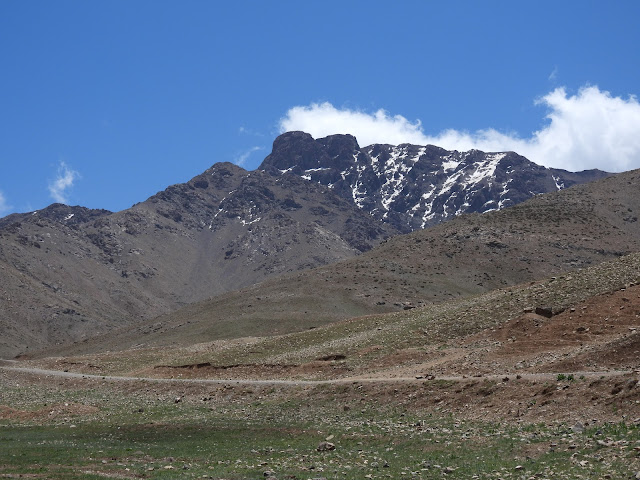










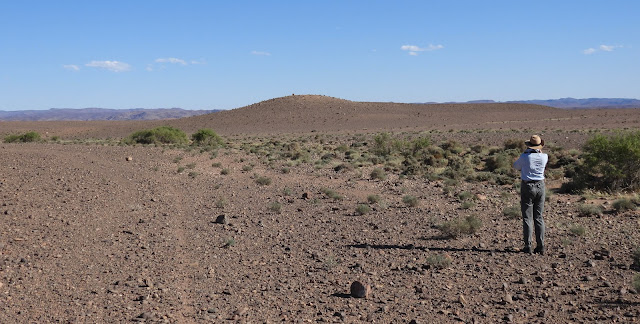


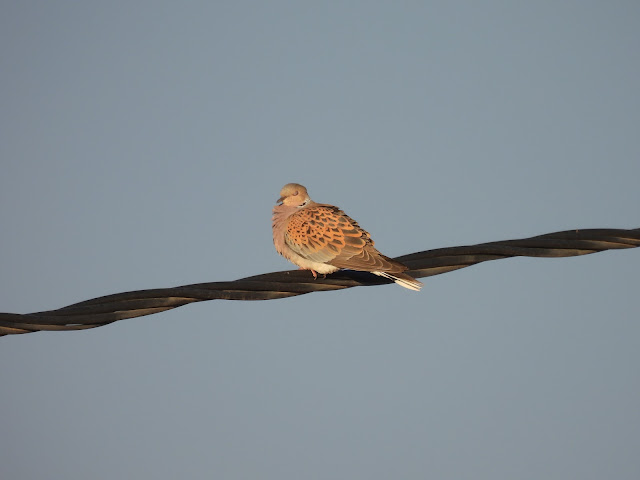







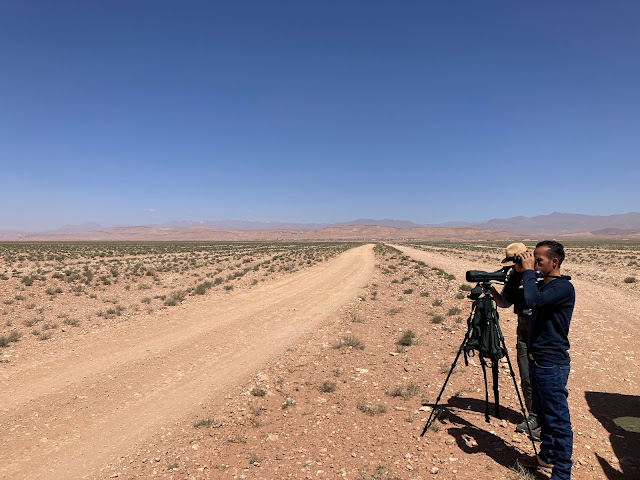
































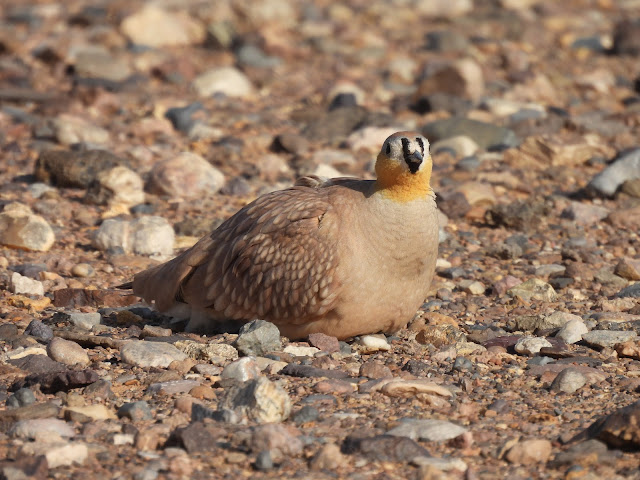











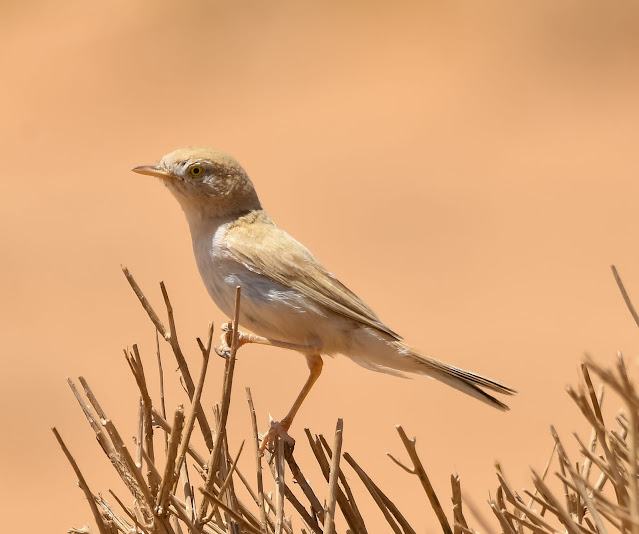

.jpeg)


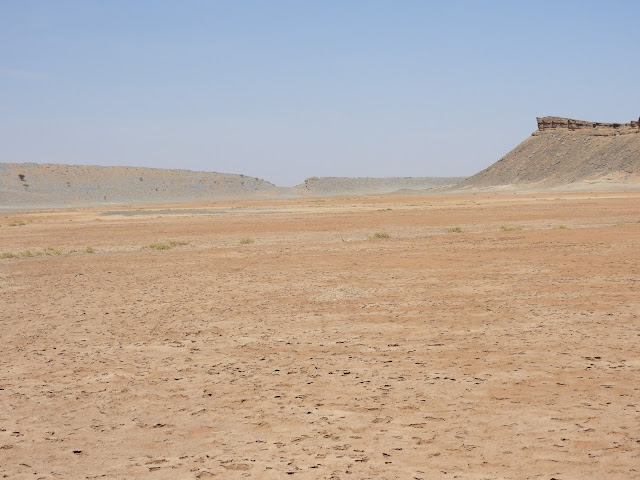








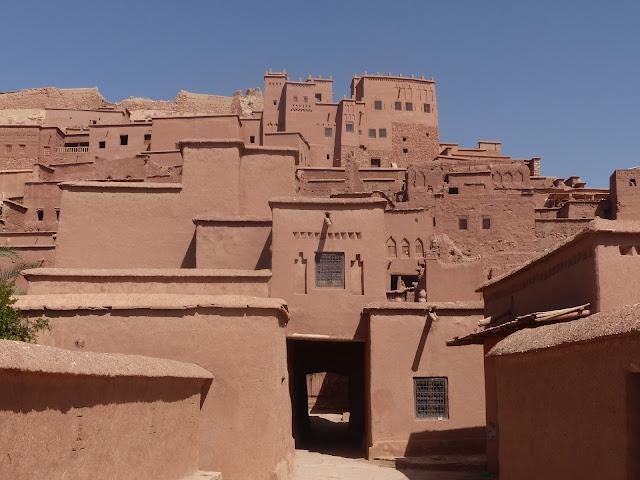






Comments
Post a Comment